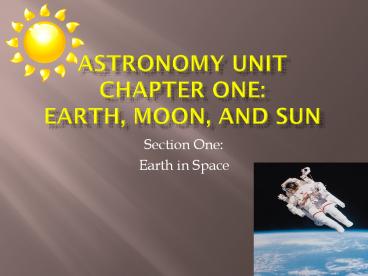Astronomy Unit Chapter One: Earth, Moon, and Sun - PowerPoint PPT Presentation
Title:
Astronomy Unit Chapter One: Earth, Moon, and Sun
Description:
Section One: Earth in Space What effects are caused by the motions of Earth and the moon? 1. Demonstrate how Earth moves in space. Explain what causes the cycle of ... – PowerPoint PPT presentation
Number of Views:52
Avg rating:3.0/5.0
Title: Astronomy Unit Chapter One: Earth, Moon, and Sun
1
Astronomy UnitChapter One Earth, Moon, and Sun
- Section One
- Earth in Space
2
Essential Question
- What effects are caused by the motions of Earth
and the moon?
3
Objectives
- 1. Demonstrate how Earth moves in space.
- Explain what causes the cycle of the seasons.
4
- Astronomy-study of moon, stars, and other space
objects - How Earth Moves in Space
- -Earth moves through space in two major ways-
rotation and revolution - Rotation
- 1. axis- imaginary line that passes through
- Earths center and the North and South poles
- 2. rotation- spinning of Earth on its axis
- a. causes night and day
- b. rotates East to West
- c. Takes about 24 hrs. for Earth to
- rotate once 1
day
5
- B. Revolution
- 1. Revolution- movement of 1 obj. around
- another
- 2. 1 complete revolution of Earth around sun
- 1 yr.
- 3. Orbit- elongated path Earth moves in
- around sun
- C. Calendars
- 1. Calendar- system of organizing time that
- defines beginning, length, and
divisions - of a yr.
6
- 2. 365 days 1 yr.
- 3. Earth orbits sun in about 365 ¼ days
- 4. Every 4 yrs there is an extra day added
- (leap year) to make up for this.
- II. The Seasons on Earth
- A. How Sunlight Hits Earth
- 1. Sunlight hits Earth most directly near
- equator warmer weather
- 2. Near poles of Earth, sunlight arrives at
- steep angles, so it is spread out
over a - greater area
7
- B. Earths Tilted Axis
- 1. Earth has seasons because its axis is tilted
- as it revolves around the sun
- 2. It is tilted at an angle of 23.5 degrees
- 3. As Earth revolves around sun, north end
- of its axis is tilted away from sun
for part - of yr.
8
- C. Earth in June
- 1. North end of Earths axis tilted toward sun
- (summer in northern hemisphere and
- winter in southern)
- D. Earth in December
- 1. Southern hemisphere receives the most
- direct sunlight (summer in southern
- hemisphere and winter in northern
- hemisphere)
- E. Solstices
- 1. Happen twice/yr in June and December
- 2. Solstice- Sun is farthest north or south of
- equator
9
- 3. Farthest north, summer solstice in
- northern Hemisphere and winter in
- southern hemisphere
- 4. Sun farthest south, winter solstice in
- northern hemisphere and summer
solstice - in southern hemisphere
- F. Equinoxes
- 1. Happen twice a yr in March and
- September
- 2. Equinox- equal night day and night are
- ea. about 12 hrs. long
10
Summary- answer the following questions in your
summary
- Explain what effects are caused by the motions of
the Earth and moon. - Explain the two ways Earth moves in space.
- Explain what causes the cycle of seasons on Earth.































